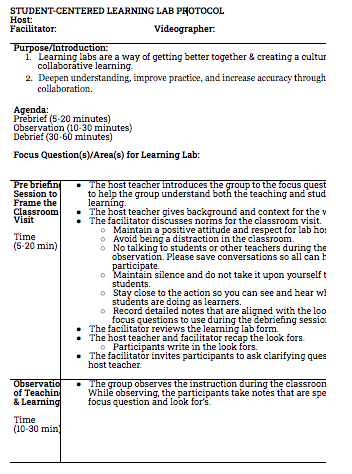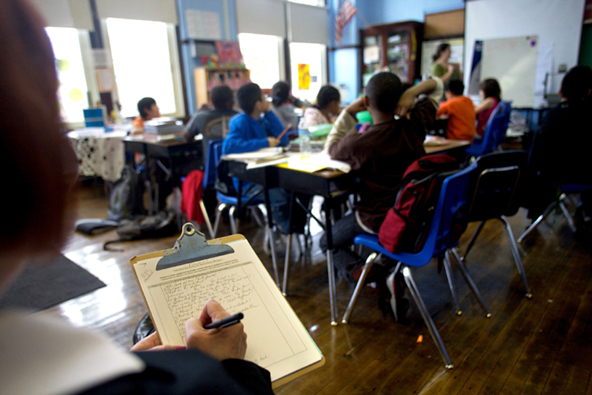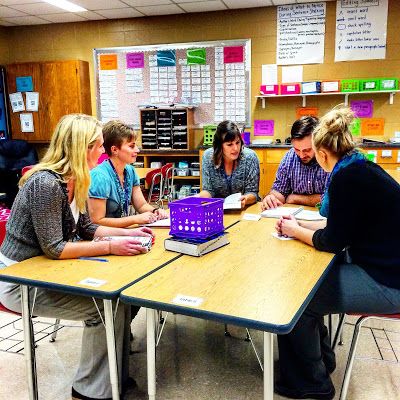This is a learning lab about how to use proficiency scales and data binders in a high school math class. I am lucky enough to work with some pretty AMAZING teachers, including Mrs. Tapper, who teaches math in our high school. Our district is moving from traditional grading to Standard Referenced Grading (SRG). Mrs. Tapper is an early adapter in our high school and has been using proficiency scales and SRG with her students for a few years now.
This year all of our K-8 teachers are using proficiency scales and SRG with their students and are required to use SRG report cards. The goal for our high school is to fully implement SRG and proficiency scales by next school year. I conducted a learning lab with Mrs. Tapper as the host teacher so that other teachers could see how she uses proficiency scales with her students and how SRG works in her classroom.
Learning Labs are a way of getting better together & creating a culture of collaborative learning. They are also a great way for teachers to see how different strategies work in real-time in other classrooms. Learning labs give teachers a visual model to teachers and are a great way to get even the most hesitant teachers to change. If they can see that a strategy works in one of their colleague’s classroom, they are more willing to try it in their own. Click here for more information on how to conduct a learning lab.
Pre-Brief: 10-30 minutes
The first step of a learning lab is the pre-brief. The pre-brief consists of a summary of what the participants will see during the visit. This could be in person or shared out in video form. I prefer sharing summary promo videos because it saves time and teachers can view it at their own convenience. Any teacher knows that teachers NEVER have enough time! Anything you, as a coach/facilitator can do to help save time will be greatly appreciated by teachers.
Prior To The Classroom Visit: 5 minutes
The second step of the pre-brief is to meet the participants outside of the classroom to summarize expectations, go through the protocol, norms, look fors and focus questions. For this particular learning lab, I handed out the learning lab protocol recording sheet, proficiency scales, aligned assessment and the student goal sheet that they were going to see the students using.

Focus Questions:
To keep the learning lab focused, the facilitator and host create specific questions that the participants will answer throughout the learning lab. This one was focused on how proficiency scales were used with students in a high school math classroom. We used the following focus questions:
- How can we use proficiency scales with the students to get them to take charge of their own learning?
- Do the students understand what level they need to be in order to be proficient?
- How do the assessments match up to the proficiency scales?
- How are the proficiency scales used to guide instruction?
Look Fors:
During the classroom visit piece of the learning lab, the participants use a recording sheet to record their observations on specific look fors. Their goal is to collect evidence for the look fors and focus questions. For this particular learning lab, there were three look fors.
- What students are putting in their data binders.
- . How the students are using their proficiency scales with their assessments.
- How the proficiency scales/assessments are used for reteaching.
Proficiency Scale Learning Lab Download

Classroom Visit: 20-45 minutes
| The group observes the instruction in a guided classroom visit format. While observing, the participants take notes that are specific to the focus question and look for’s. Participants use the Learning Lab Note-Taking Tool (We will use this for the debrief) created for them to record their observations. All of the look fors and focus questions were based on how students in the high school math classroom used their proficiency scales within their learning of math content. Participants MUST follow the Learning Lab Norms. |
Post-Brief: 30-60 minutes
The post-brief takes place after the classroom visit. The participants meet with the host teacher and facilitator to reflect on their findings, ask questions. The post-brief follows a specific protocol and is held in a whip-around format. The post-brief consists of four rounds. The first two rounds are based on thoughts from the learning lab participants about what they saw in their visit based on how students use proficiency scales.
- The host teacher holds their thoughts until round three.
- The facilitator takes notes during all four rounds of the post-brief.

Round 1: Student Evidence
The first round of the learning lab focuses on discussing student evidence collected during the classroom visit. Participants share the evidence they collected that met the look fors and focus questions in a whip around fashion using one of the following discussion stem options:
- I saw…
- I heard…
Round 2: Implications
The second round of the learning lab focuses on the broader implications for the participants. Based on the participant’s observations, what does it mean for their teaching? What can they take away from their observations to implement in their own classrooms? What can they take away to use to use proficiency scales with their students? Learning lab participants use one of the following discussion stem options:
- Based on _______, I think….
- Because I saw _______, I wonder if…..
Round 3: Response From The Host Teacher
The third round of the learning lab focuses on the host teacher’s responses to what has been shared thus far. How has the host teacher’s thinking changed? What is a future goal for instruction? How will student learning be assessed? The host teacher responds using the following discussion stem options:
- I feel….
- From what I heard, I’m thinking…..
- My next step would be….
Round 4: Next Steps & Support Needed
The final step in the learning lab protocol is the debrief. This is where the participants share the next steps for their own work that arose from the observations. Participants share ah-ha moments, takeaways and new learning that will influence teaching in their own classrooms. The facilitator takes notes for future follow-up and coaching and support needed. The learning lab participants respond using the following discussion stem options:
- A goal I could set for myself is…..
One or two aspects from the observation that I could use in my own instruction are….
- I realize my students….
- I would like to try….
- I need help with…
Resources:
I learned a lot from my research on standard-referenced grading and proficiency scale creation through researchers like Robert Marzano, Ken O’ Connor, John Hattie, Tom Guskey and Rick Wormeli. If you are interested in learning more about SRG and proficiency scales, I definitely recommend the following books.
For more information about Learning Labs click here!